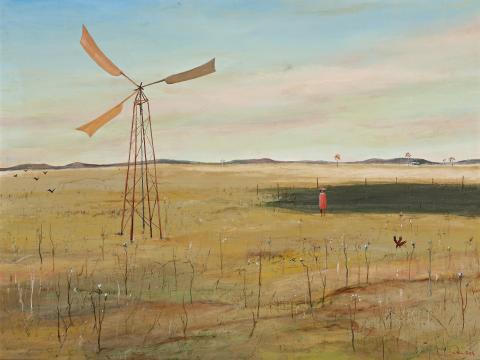BURNT STUBBLE WIMMERA, c.1975
ARTHUR BOYD
oil on board
91.0 x 120.0 cm
signed lower right: Arthur Boyd
bears inscription verso: BURNT STUBBLE – WIMMERA
Private collection, Perth
Lister Gallery, Perth
Private collection, Perth, acquired from the above c. 1995
Private collection, Brisbane
From his earliest impressionist views of the Mornington Peninsula outside Melbourne to the masterly depictions of his beloved Shoalhaven River, Arthur Boyd demonstrated a continuing fascination with the Australian landscape. His eye was drawn to the nuances and ever-changing vagaries of nature, from the primordial tangle of the Australian bush to the various ways humanity had intervened with farming and mining. This preoccupation continued overseas at his English and Italian residences and where ‘(i)n a snow-bound studio he … envisioned the desert: in a garden of ash and maple trees, he … painted gum and wattle’.1 Burnt Stubble, Wimmera, c.1975 is an evocative example of this aspect of Boyd’s expatriate’s vision, for ‘the Australian landscape, strongly held in memory, was as accessible to him in his Suffolk Studio as anywhere else’.2
Boyd first visited the Wimmera in Victoria’s heat-shimmered north-west in the summer of 1948-49, painting at the border of the Wimmera River. Many of the landscapes from this period are recognised masterworks by the artist and he continued to paint variations at different times in his life. These were not copies of or even homages to the earlier works; rather, each was a return by the artist to a treasured memory seeking to re-depict it in a manner more closely aligned to his current psychological state of mind, creating a painterly oasis for calm reflection. During the 1970s, Boyd exhibited extensively in London and Australia, and following a visit to one such show at Fischer Fine Art, his younger colleague Brett Whiteley wrote to Boyd that ‘it really is remarkable and masterly of you to be able to hold that dry white heat of the bush in your head from 12,000 miles … So really congratulations on the feeling of pale intense beauty you have pulled out of the Australian bush, its such a great subject’.3
In Burnt Stubble, Wimmera it would seem that recent rains have added a soft flush of green to the cleared fields of wheat and it is this particular colouring that evokes the mood of the Suffolk fields. Beyond the spiky thistles of the foreground, Boyd has characteristically included the low rise of the Grampians in the distance, crows to the left and a darting raptor to the right. Also in the distance is a solitary blue homestead, the probable home for the young child who looks out quietly from the burnt ground, observing, even wary, whilst all about is a ‘deafening’ silence, broken only by the rusty squeal caused by the idiosyncratic windmill. In spite of this subdued tenor, Burnt Stubble, Wimmera remains an inviting and nostalgic elegy to a beloved land by a treasured Australian artist many thousands of miles from his home.
1. McGrath, S., ‘Boyd still the master’, The Australian, Sydney, 12 March 1980
2. Niall, B., The Boyds, Melbourne University Press, Victoria, 2007 (2002), p. 342
3. Whiteley, B., 1977, quoted in Bungey, D, Arthur Boyd: a life, Allen and Unwin, Sydney, 2007, p. 497
ANDREW GAYNOR
